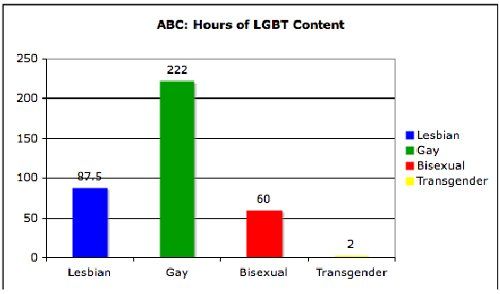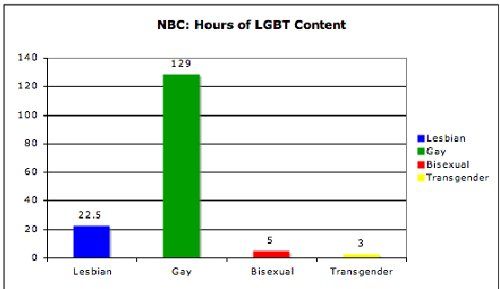AFAICT, GLAAD started and stopped by collecting the most easily quantifiable data: the number of hours of original primetime network programming that included an LGBT character, and the (perceived) race of said characters. In all fairness, this was probably a *ton* of work.
While GLAAD makes commentary on how LGBT characters on each network are represented, I'm not sure how this is represented in the data. On one level, this seems fair: we could sit here all day arguing about what constitutes a positive portrayal of LGBT people (see Family, Modern). It would be nice, however, to know what percentage of transgender characters/people were transsexual women, and how much airtime was devoted to their genitals, their medical history, and/or their prowess as models, singers and/or fashionistas.
Not surprisingly, plenty of networks that had significant LGBT content exhibited race fail. While GLAAD gave ABC a "good" grade for LGBT representation, 87% of said representation was of white LGBT people. Of course, I'm not sure what the null hypothesis is here-- surely people of color are underrepresented on television.
And now for my [least] favorite part-- comparisons within the LGBT spectrum. Graphs! below the jump.
GLAAD makes the standard assumption that the LGBT represents four categories that represent all queer people. And they make nifty graphs! (Although I'm not sure why the resolution on them is wonky.)
Here's ABC, which scored a "good" for 297.5 "LGBT-Inclusive Hours" (26% of ABC programming)

[Hours of LGBT Content: Lesbian 87.5, Gay 222, Bisexual 60, Transgender 2]
NBC scored an "adequate" for 151 "LGBT-Inclusive Hours" (13% of NBC programming)

[Hours of LGBT Content: Lesbian 22.5, Gay 129, Bisexual 5, Transgender 3]
And then there's ABC Family. It scored a "good" for 36.5 "LGBT-Inclusive Hours" (37% of ABC Family programming)

[Hours of LGBT Content: Lesbian 1, Gay 35, Bisexual 0.5, Transsexual 0]
I'm hardly surprised that gay men make up the bulk of "LGBT" representation on U.S. television. As far as lesbian representation is concerned, fully-formed female characters are generally rare on TV. That said, I'm guessing that close to 100% of U.S. television programming features at some type of female character; even Bruce Pornstache mentions Tammy on occasion.
I am a bit peeved (although also unsurprised) that GLAAD trumpets this study as proof of the gains "LGBT" people have been making. What else is new, I suppose. Hooray for intersectionality.




Shakesville is run as a safe space. First-time commenters: Please read Shakesville's Commenting Policy and Feminism 101 Section before commenting. We also do lots of in-thread moderation, so we ask that everyone read the entirety of any thread before commenting, to ensure compliance with any in-thread moderation. Thank you.
blog comments powered by Disqus